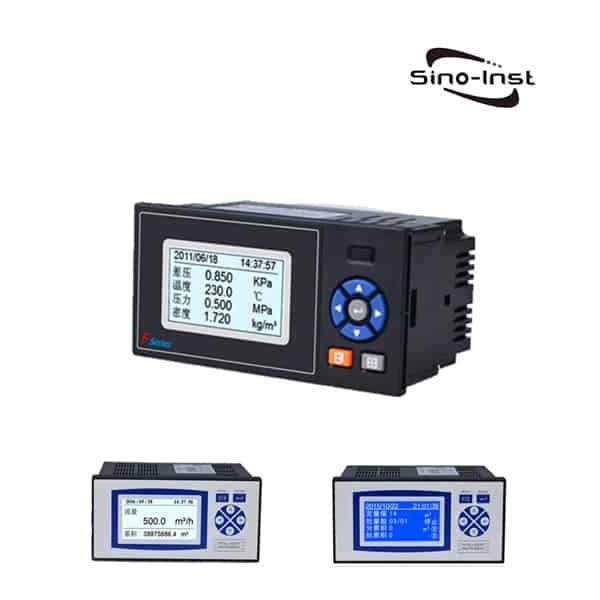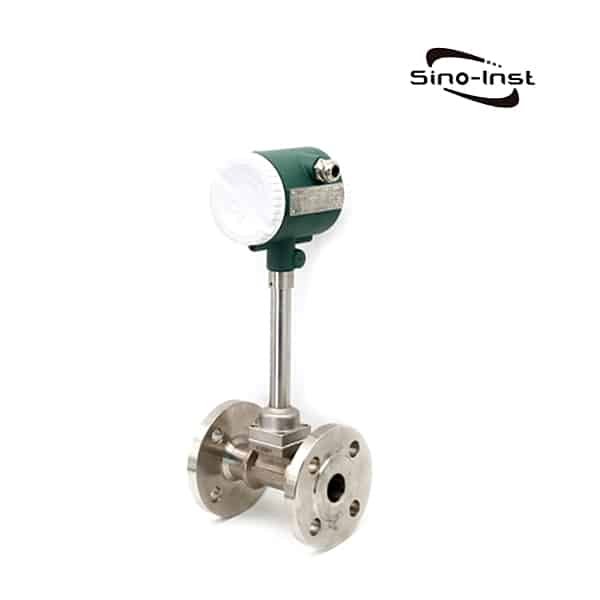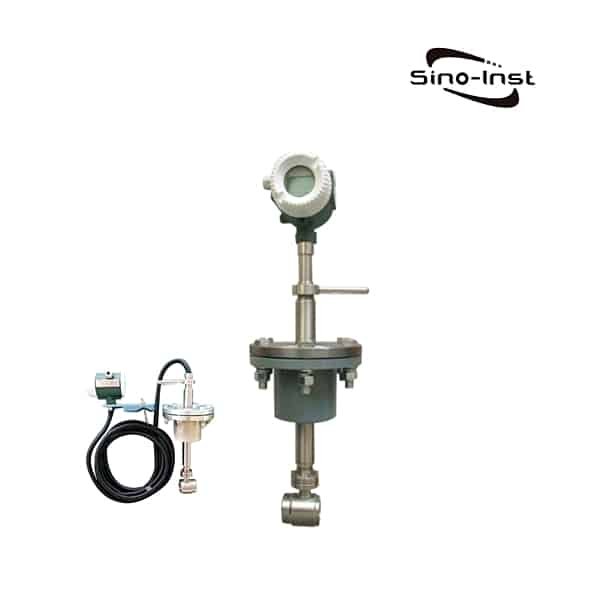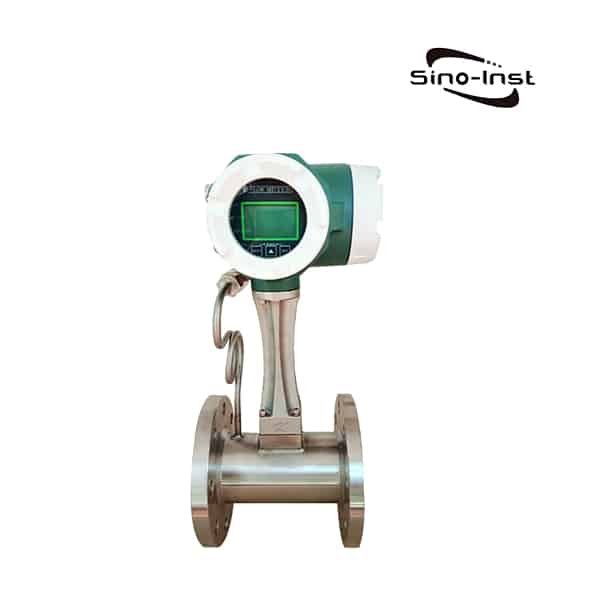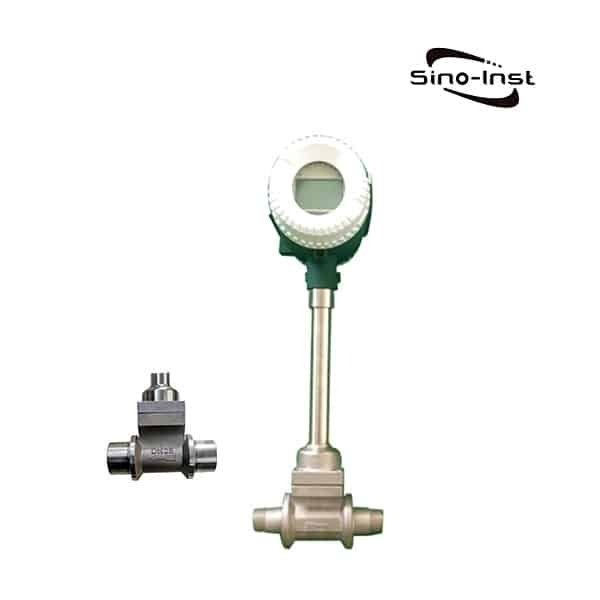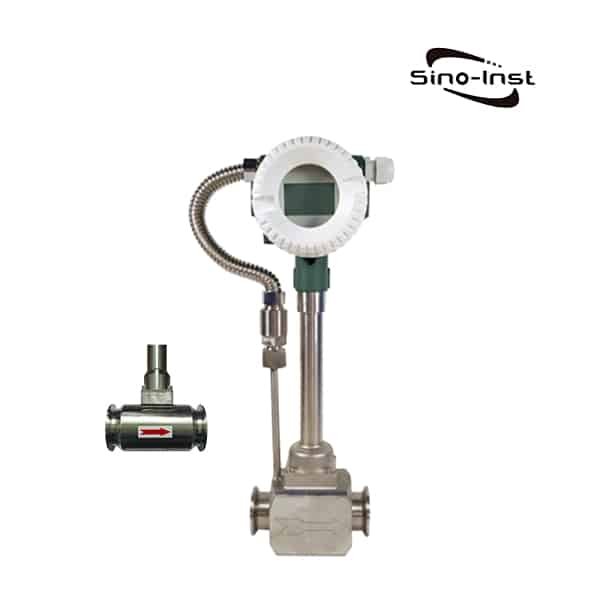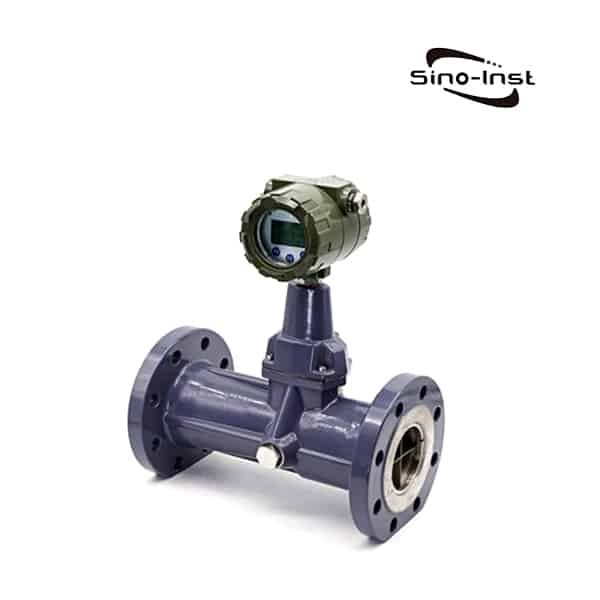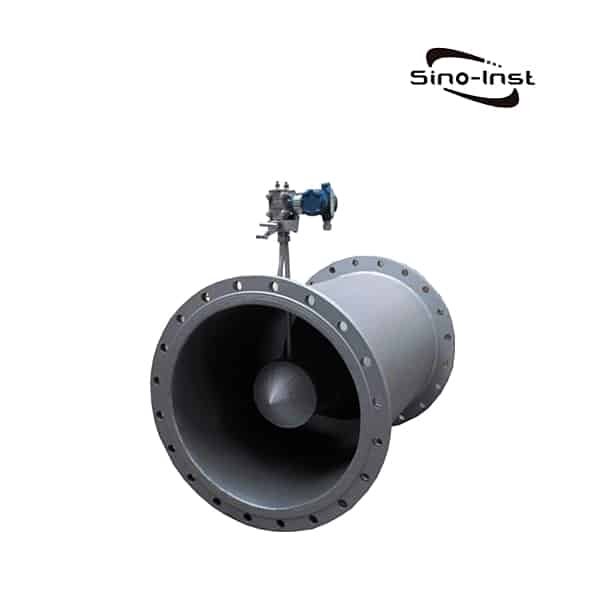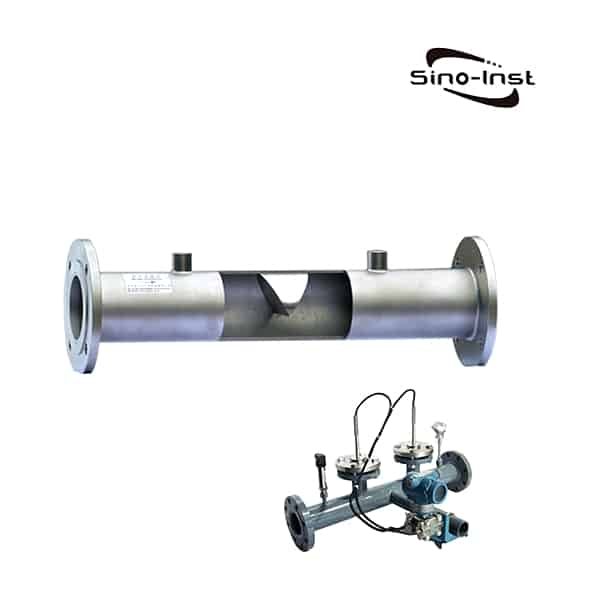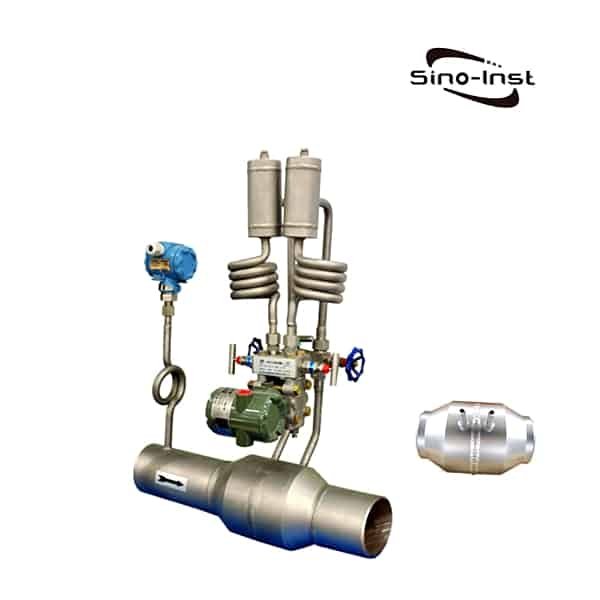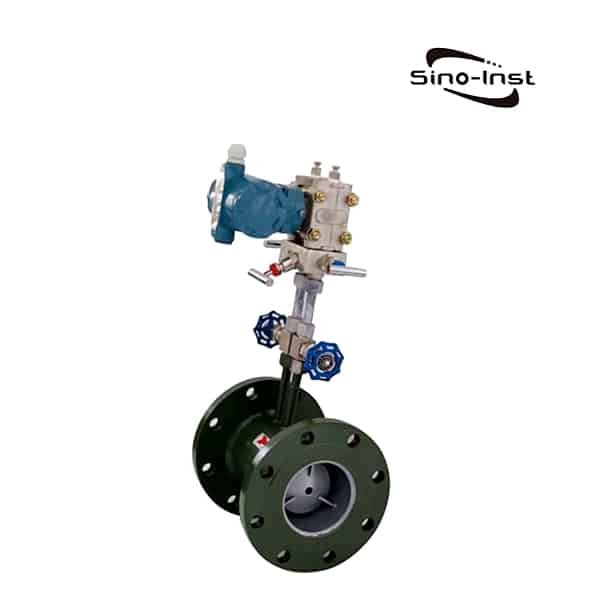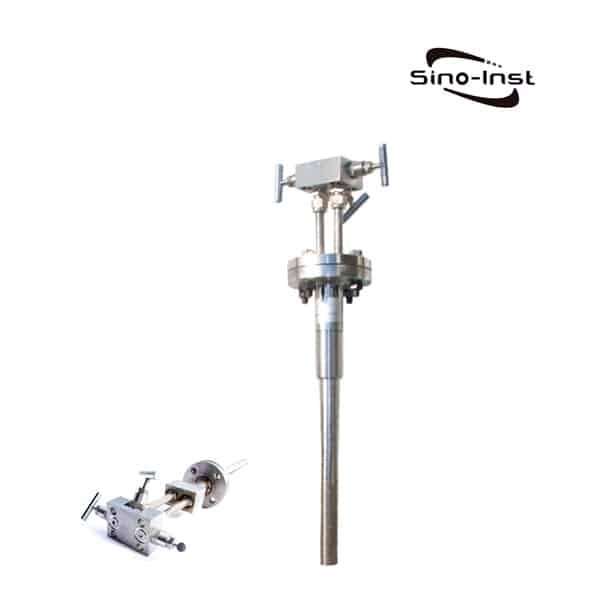Steam flow meter is mainly used for the steam flow measurement. The vortex flow meter concentrates temperature and pressure compensation. Can measure superheated/saturated steam, liquid and gas.
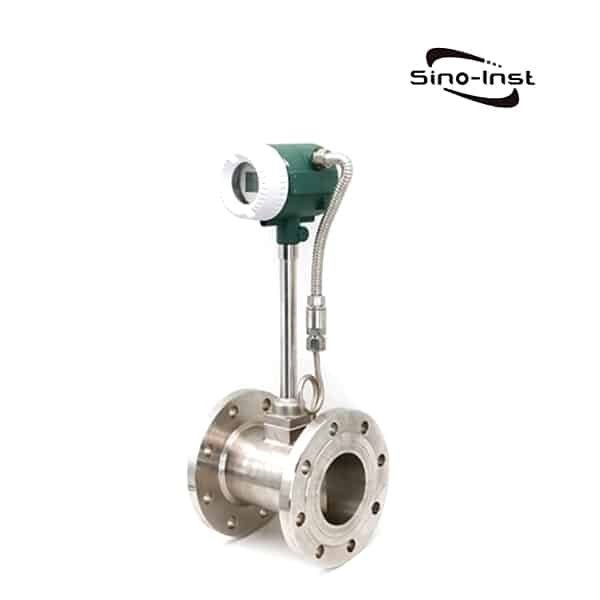
The vortex steam flow meter concentrates temperature and pressure compensation in the vortex flowmeter. Automatically detect the temperature and pressure of the medium in the pipeline, and the density automatically participates in the calculation. It can display the instantaneous mass flow and cumulative mass flow of the medium. It can also display the temperature and pressure of the medium. It can measure liquid, general gas, saturated steam, superheated steam, etc.
Vortex steam flow meter reference price: USD 200-1500/pc.
Sino-Inst offers a variety of Vortex flow meters for flow measurement. If you have any questions, please contact our sales engineers.
Features of Steam Flow Meter
- Easy to install. It is suitable for the measurement of steam, compressed air and other gases;
- Integrated temperature and pressure dual compensation. The instantaneous flow and accumulated flow, temperature, pressure and other data after compensation can be directly read on the meter head;
- It has a very unique medium versatility. It can be used for flow measurement and control of most steam, gas and liquid;
- Simple structure, no holes and gaps design. No wear, dirt resistance, no moving parts, low failure rate. It has high stability and reliability;
- The vortex flowmeter uses the latest signal processing technology, and the entire system analyzes the measured signal. Then eliminates external interference and media disturbance. Therefore, stable measurement can be achieved even in harsh process conditions;
- The piezoelectric element of the vortex flowmeter is embedded in the probe body. It does not touch the medium. There is no filling material inside. The pressure loss is small and the service life is long;
- The original signal formed by the vortex flowmeter. Its output frequency has a linear relationship with the flow rate. There is no zero drift problem;
- Adopt advanced digital signal processing technology. Low lower limit. Excellent anti-vibration performance.
Read more about: Steam pressure transmitter-Pressure measure on steam pipeline
Vortex Steam Flow Meter Specification
| Measuring medium | Superheated/saturated steam, liquid and gas |
| Measuring range | See flow range table for details |
| caliber | Wafer type/flange type: DN15~DN400~DN1000 |
| Medium temperature (℃) | (-40~80)℃, (-40~150)℃, (-40~300)℃, (-40~400)℃ |
| Environment temperature (℃) | (-20~+70)°C atmospheric pressure: 86kPa~106kPa |
| Nominal pressure | Liquid 1.6MPa, 2.0MPa, 2.5MPa, 4.0MPa, 5.0MPa, 6.3MPa, 10.0MPa, 25MPa Gas and steam 1.6MPa, 2.0MPa, 2.5MPa, 4.0MPa, 5.0MPa |
| Accuracy | ±1.0%, ±1.5% |
| Flow rate range (m/s) | Liquid: 0.15~7 Gas: 1.5~60 Steam: 2~70 |
| output signal | Three-wire voltage pulse: high level≥5V low level<1V Standard current signal: (4-20) mA standard current signal proportional to the flow rate, local display flow, cumulative flow. And output proportional to the flow rate (4-20) mA standard current signal and pulse frequency signal Communication method: RS-485 communication |
| Power supply | Three-wire voltage pulse: DC12V, DC24V Standard current output, local display: DC24V Battery power supply (lithium battery): 3.6V |
| Ambient temperature | (-20~+70)°C atmospheric pressure: 86kPa~106kPa |
| Protection level | IP65 |
| Explosion-proof grade | Intrinsically safe Ex ia ⅡC T6 Ga |
| display | LCD displays instantaneous flow, cumulative flow, vortex frequency, temperature and pressure (integrated temperature and pressure) |
| Cable interface | M20×1.5 (internal thread, recommended); 1/2NPT (internal thread) |
| Installation form | Integrated installation; split installation (the measuring tube and the indicator are connected by a 10-core special shielded cable) |
| Diameter (DN) | Liquid flow range (m3/h) | Output frequency range (Hz) | Gas flow range (m3/h) | Output frequency range (Hz) |
| 15 | 1.2~6.2 | 90~900 | 5~25 | 265~2640 |
| 20 | 1.5~10 | 40~396 | 8~50 | 218~1982 |
| 25 | 1.6~16 | 32~325 | 10~70 | 172~1420 |
| 32 | 2~20 | 20~250 | 15~150 | 130~1350 |
| 40 | 2.5~25 | 13~130 | 22~220 | 115~1147 |
| 50 | 3.5~35 | 9~93 | 36~320 | 96~854 |
| 65 | 6~60 | 8~82 | 50~480 | 61~583 |
| 80 | 10~100 | 6~65 | 70~640 | 45~417 |
| 100 | 15~150 | 5~50 | 130~1100 | 43~367 |
| 125 | 25~250 | 5~47 | 200~1700 | 33~290 |
| 150 | 40~400 | 4~40 | 280~2240 | 27~221 |
| 200 | 80~800 | 3~33 | 580~4960 | 24~207 |
| 250 | 140~1400 | 3~26 | 970~8000 | 20~171 |
| 300 | 200~2000 | 2~22 | 1380~11000 | 17~136 |
Extended reading: Flow Totalizer F3000X for Data collection and calculation
Vortex Steam Flow Meter Applicaitons
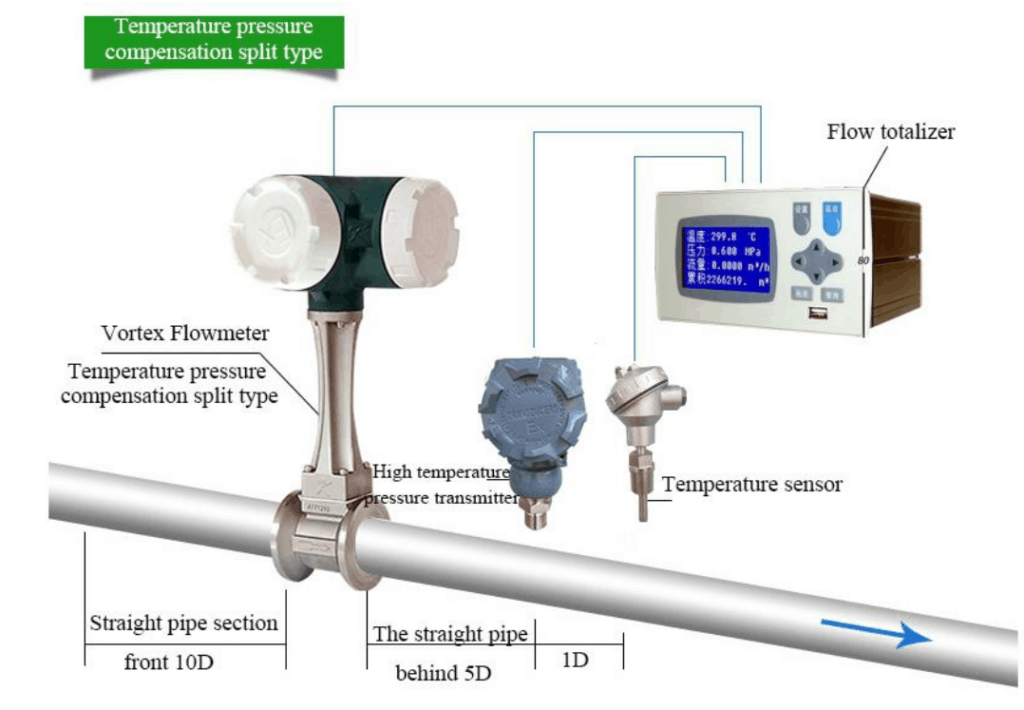
- And saturated steam flow measurement
- Steam boiler monitoring
- Compressor air monitoring
- Measure the consumption of compressed air system
- Measure industrial gas consumption
- SIP and CIP processing in the food, beverage and pharmaceutical industries
Extended reading: Measuring Flow With Pressure Sensors
What is the principle of vortex Steam flow meter?
Or, How steam flow is measured?
How is the steam flow rate calculated?
The basic principle of the intelligent vortex flowmeter, is the Karman vortex principle. That is “the vortex separation frequency is proportional to the flow velocity”.
The diameter of the flowmeter body is basically the same as the nominal diameter of the meter. The axis of the cylinder is perpendicular to the flow direction of the measured medium, and the bottom surface greets the fluid.
When the measured medium flows through the cylinder, Vortex is alternately generated on both sides of the column, and the vortex is continuously generated and separated.
In the downstream of the column, two rows of vortices, namely “vortex street”, are formed. Theoretical analysis and experiments have shown, that the frequency of vortex separation is proportional to the flow rate of the column side medium.
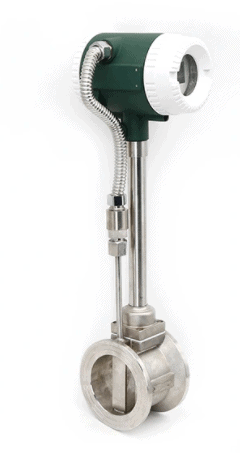
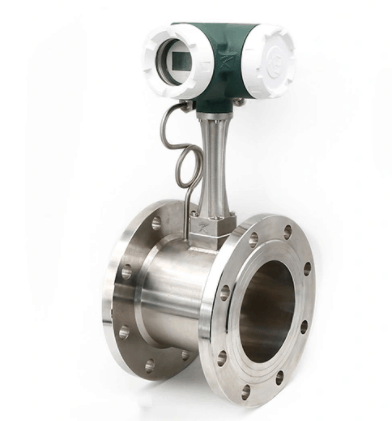
f=(sr*V)/d
In the formula:
F── the frequency of the vortex separation of the column side (Hz);
V── column side flow rate (m/s);
D── the width of the cylinder facing surface (m);
Sr ─ Strauhal number.
It is a constant that is substantially independent of fluid properties, and flow rate depending on the shape of the cross-section of the cylinder.
Extended reading: Liquid Bitumen/Asphalt Flow Meter
Temperature and pressure compensation of vortex steam flowmeter
Gases are compressed fluids. If its volume state has changed. It is mainly caused by changes in temperature and pressure indicators.
In the process of measuring the gas flow, on the one hand, the flowmeter must be able to accurately output the standard volume flow. On the other hand, the output of mass flow is also required.
And the vortex flowmeter is used to measure the volume flow. It is necessary to ensure that the measurement is carried out in the environment of the working condition. Therefore, the vortex flowmeter is used in the measurement process of general gas and steam. The temperature and pressure compensation function should be fully considered. And make a reasonable instrument selection.
After temperature and pressure compensation, the volume flow of the working condition can be converted into a mass flow. Or it is converted into other volume flow, that is, the standard volume flow.
For general gases during measurement. The compensation principle is to calculate according to the formula, which belongs to the standard gas state equation:
P0V0/T0= P1V1/T1.
where:
The absolute pressure (Pa) in the standard state represented by P0;
The absolute pressure (Pa) in the working state represented by P1;
T0 represents the thermodynamic temperature (K) in the standard environment;
T1 represents the thermodynamic temperature (K) under working conditions;
V0 represents the gas volume in the standard environment;
V1 is the gas volume in the operating state.
Extended reading: How to realize the flow accumulation function in PLC?
During the steam measurement. The work that needs to be done is the compensation of saturated steam. There are two methods of application, one is pressure compensation and the other is temperature compensation.
There are usually two specific compensation modes.
That is, if the vortex flowmeter sensor does not have a temperature detection element and built-in pressure. Static compensation can only be implemented inside the instrument. That is to say, the compensation is realized by inputting the fixed pressure value and temperature value. This mode is more suitable for occasions without large temperature and pressure changes.
If the vortex flowmeter sensor has a temperature detection element and built-in pressure. The meter takes into account the results of the measured temperature and pressure. Master the state of steam. Determine which type of steam is superheated steam or saturated steam.
For mass flow, the calculation method needs to obtain the steam database index stored in the instrument and implement intelligent calculation. The other is to use the steam flow totalizer. in the steam flow totalizer. The volume flow and temperature of the working conditions measured by the transmission vortex flowmeter. And to transmit the signal measured by the pressure transmitter.
The steam flow totalizer has built-in superheated steam and saturated steam compensation algorithms. Can accurately output mass flow and standard volume flow. Moreover, the heat and specific enthalpy can be output correctly.
Extended reading: How to Calibrate DP Level Transmitter
Steam Flow Meter Types
Commonly used flow meters for steam flow measurement include: differential pressure flow meters, vortex flow meters, rotary wing steam flow meters, V cone flow meters, elbow flow meters, and flute-shaped uniform velocity tube flow meters. These steam flow meters work principles and The usage requirements are different.
Sino-Inst shares the knowledge of these steam flow meters with you.
Extended reading: metal tube flow meter
Clamp on Steam Flow Meter
The clamp-on ultrasonic flowmeter cannot measure steam. Generally, it measures the flow of medium such as water and uniform liquid.
The measurement of steam generally uses a temperature and pressure compensated vortex flowmeter or a differential pressure flowmeter.
Portable Steam Flow Meter
The FLUXUS G601 ST is the world’s ONLY clamp on steam meter! This device is able to measure steam flow non-invasively from outside the pipe which means that there is no interruption of operation or supply. This also means there is no pressure loss, need to open the pipe, or to reduce the pipe size for measurement.
Read more about: Condensate Flow Meter-Steam Condensate Flow Meter|Types & Selection Guide
Featured Steam Flow Meters
Related Blogs:
Frequently
Asked
Questions
All of our Flow Meters can work with the NEW AMS TREX !
Sino-Instt offer over 10 Vortex Shedding flow meters, with Best Price.
A wide variety of industrial Vortex shedding flow meters options are available to you, such as free samples, paid samples. All of our flow meters can wokrk with the AMS NEW TREX.
About 13% of these are magnetic flow meter, 14% are Insertion Magnetic Flow Meter, 25% are Venturi flow meter, 13% are Handheld ultrasonic flow meter, and others are Liquid Turbine Flow Meters.
Sino-Inst is Vortex shedding flow meter suppliers, located in China. Vortex shedding flow meter products are most popular in North America, Mid East, and Eastern Europe.
Request a Quote

Wu Peng, born in 1980, is a highly respected and accomplished male engineer with extensive experience in the field of automation. With over 20 years of industry experience, Wu has made significant contributions to both academia and engineering projects.
Throughout his career, Wu Peng has participated in numerous national and international engineering projects. Some of his most notable projects include the development of an intelligent control system for oil refineries, the design of a cutting-edge distributed control system for petrochemical plants, and the optimization of control algorithms for natural gas pipelines.

